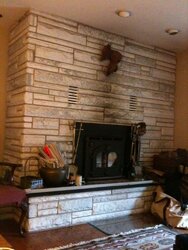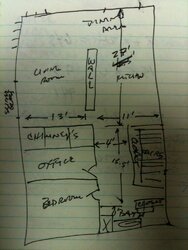I purchased a Morso 1710 insert in 2008 and have it in an 'old heatilator fireplace' with a lot of stone on a raised hearth, on the main floor (upstairs) and an interior chimney. My house footprint is 24x53 so about 1275 sqft on each floor. The upstairs living room, kitchen and dining area + hall to bedrooms is about 675 sqft when bedroom doors are closed, and is an open floor plan with only a 14 foot dividing wall between the living room and kitchen. The 1710 has a small firebox (~1.3cuft) and is rated at 39,000 btu max, and is a passive convection setup (I've tried adding a fan and it makes little difference although the ceiling fans do). The house is probably average, or below, insulation with vinyl siding and about an inch of blue foam board and blown in cellulose in the attic. But the living room has a lot of windows, they are insulated but glass never the less, and a big sliding glass door so that wall is actually more glass than not, or pretty close. I average about 200 gallons of fuel oil a month for baseboard and domestic hot water. I figure thats about 38,000 btu/hr during the heating season I purchased the stove for supplemental heat to help offset some of the fuel oil expense, and to satisfy my pyrophillic tendencies.
I suspect the 1710 was maybe not the best choice for this house/raised hearth/lotta stone fireplace and I'm thinking perhaps a radiant stove, hearth mounted, might work better and turn the old heatilator into a big masonry heater faster. The stone work does heat up nicely and I do get some convection going through the heatilator vents but takes a looong time to do so. The fireplace opening is only about 28" in height so limits somewhat which stoves I can fit. I also have about a nine inch shelf from the raised hearth. I like the Morso contemporary styling, quality castings, and simple controls, plus the internal ash pan makes for a simpler setup with fewer moving parts, gaskets etc. They do also have short legs available for hearth mounting the Morso 2110 and 3610 stoves.
I've been running this stove pretty hard and I'm waiting for an infrared pyrometer so I can check temps better. I have a magnetic spring type thermometer mounted on the upper left side of the stove front and it's seen 700*F probably too often though not for extended periods.

Not sure if I'm just being impatient or if I went too small or if I should have gone radiant instead of convection. I don't run the stove 24/7 though it would be nice if it could keep things comfy should we have another power failure in the dead of winter, and on the weekend. I'm leaning towards the 3610 because I think I need at least a 2 cuft firebox and about 50 to 60,000 btu max to get closer to an average 30,000 btu/hr. The 2110 is rated about the same as the 1710 and would be more of a lateral move to a radiant stove. I figure either one, if mounted forward on the raised hearth, might get some of the heat out into the room faster and let me sit on the couch instead of right up next to the stove on those blustery winter nights.
I've learned alot on this website though still can't make a decision to save my life! I welcome your thoughts, insights and knowledge and greatly appreciate your taking the time to read this very long post. Did I forget anything?
I suspect the 1710 was maybe not the best choice for this house/raised hearth/lotta stone fireplace and I'm thinking perhaps a radiant stove, hearth mounted, might work better and turn the old heatilator into a big masonry heater faster. The stone work does heat up nicely and I do get some convection going through the heatilator vents but takes a looong time to do so. The fireplace opening is only about 28" in height so limits somewhat which stoves I can fit. I also have about a nine inch shelf from the raised hearth. I like the Morso contemporary styling, quality castings, and simple controls, plus the internal ash pan makes for a simpler setup with fewer moving parts, gaskets etc. They do also have short legs available for hearth mounting the Morso 2110 and 3610 stoves.
I've been running this stove pretty hard and I'm waiting for an infrared pyrometer so I can check temps better. I have a magnetic spring type thermometer mounted on the upper left side of the stove front and it's seen 700*F probably too often though not for extended periods.

Not sure if I'm just being impatient or if I went too small or if I should have gone radiant instead of convection. I don't run the stove 24/7 though it would be nice if it could keep things comfy should we have another power failure in the dead of winter, and on the weekend. I'm leaning towards the 3610 because I think I need at least a 2 cuft firebox and about 50 to 60,000 btu max to get closer to an average 30,000 btu/hr. The 2110 is rated about the same as the 1710 and would be more of a lateral move to a radiant stove. I figure either one, if mounted forward on the raised hearth, might get some of the heat out into the room faster and let me sit on the couch instead of right up next to the stove on those blustery winter nights.
I've learned alot on this website though still can't make a decision to save my life! I welcome your thoughts, insights and knowledge and greatly appreciate your taking the time to read this very long post. Did I forget anything?


